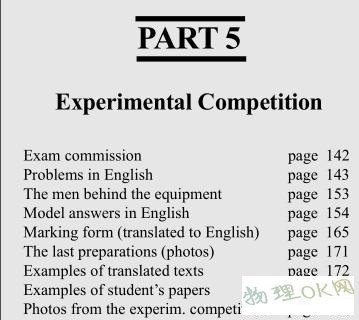国际物理林匹克竞赛试题27-39(英文版)
来源:物理ok网
编辑:黄水楠
时间:2017-04-30
点击量:次
Figure 1. The instrumentation used.
SAFETY HAZARD: Be careful with the two vertical blades on the large
stand. The blades are sharp!
Photo: Geir Holm
146
THE PHYSICAL PENDULUM
A physical pendulum is an extended physical object of arbitrary shape that can
rotate about a fixed axis. For a physical pendulum of mass M oscillating about
a horizontal axis a distance, l, from the centre of mass, the period, T, for small
angle oscillations is
T
g
I
M l
l = +
2 π
(1)
Here g is the acceleration of gravity, and I is the moment of inertia of the pen-
dulum about an axis parallel to the rotation axis but through the centre of mass.
Figure 2 shows a schematic drawing of the physical pendulum you will be us-
ing. The pendulum consists of a cylindrical metal rod, actually a long screw,
having length L, average radius R, and at least one nut. The values of various
dimensions and masses are summarised in Table 1. By turning the nut you can
place it at any position along the rod. Figure 2 defines two distances, x and l,
that describe the position of the rotation axis relative to the end of the rod and
the centre of mass, respectively.
Figure 2: Schematic drawing of the pendulum
with definition of important quantities.
147
Rod
Length L (400.0 ± 0.4) mm
Average radius R (4.4 ± 0.1) mm
Mass M ROD (210.2 ± 0.2) ?10 -3 kg
Distance between screw threads (1.5000 ± 0.0008) mm
Nut
Height h (9.50 ± 0.05) mm
Depth of groove d (0.55 ± 0.05) mm
Mass M NUT (4.89 ± 0.03) ?10 -3 kg
Table 1: Dimensions and weights of the pendulum
A reminder from the front page: No points will be given for error estimates ex-
cept in 2c. However, it is expected that the correct number of significant fig-
ures are given.
Section 1 : Period of oscillation versus rotation axis position
(4 marks)
a) Measure the oscillation period, T, as a function of the position x, and present
the results in a table.
b) Plot T as a function of x in a graph. Let 1 mm in the graph correspond to
1 mm in x and 1 ms in T. How many positions give an oscillation period equal
to T = 950 ms, T = 1000 ms and T = 1100 ms, respectively?
c) Determine the x and l value that correspond to the minimum value in T.
Section 2 : Determination of g (5 marks)
For a physical pendulum with a fixed moment of inertia, I, a given period, T,
may in some cases be obtained for two different positions of the rotation axis.
Let the corresponding distances between the rotation axis and the centre of
mass be l 1 and l 2 . Then the following equation is valid:
下载地址:
SAFETY HAZARD: Be careful with the two vertical blades on the large
stand. The blades are sharp!
Photo: Geir Holm
146
THE PHYSICAL PENDULUM
A physical pendulum is an extended physical object of arbitrary shape that can
rotate about a fixed axis. For a physical pendulum of mass M oscillating about
a horizontal axis a distance, l, from the centre of mass, the period, T, for small
angle oscillations is
T
g
I
M l
l = +
2 π
(1)
Here g is the acceleration of gravity, and I is the moment of inertia of the pen-
dulum about an axis parallel to the rotation axis but through the centre of mass.
Figure 2 shows a schematic drawing of the physical pendulum you will be us-
ing. The pendulum consists of a cylindrical metal rod, actually a long screw,
having length L, average radius R, and at least one nut. The values of various
dimensions and masses are summarised in Table 1. By turning the nut you can
place it at any position along the rod. Figure 2 defines two distances, x and l,
that describe the position of the rotation axis relative to the end of the rod and
the centre of mass, respectively.
Figure 2: Schematic drawing of the pendulum
with definition of important quantities.
147
Rod
Length L (400.0 ± 0.4) mm
Average radius R (4.4 ± 0.1) mm
Mass M ROD (210.2 ± 0.2) ?10 -3 kg
Distance between screw threads (1.5000 ± 0.0008) mm
Nut
Height h (9.50 ± 0.05) mm
Depth of groove d (0.55 ± 0.05) mm
Mass M NUT (4.89 ± 0.03) ?10 -3 kg
Table 1: Dimensions and weights of the pendulum
A reminder from the front page: No points will be given for error estimates ex-
cept in 2c. However, it is expected that the correct number of significant fig-
ures are given.
Section 1 : Period of oscillation versus rotation axis position
(4 marks)
a) Measure the oscillation period, T, as a function of the position x, and present
the results in a table.
b) Plot T as a function of x in a graph. Let 1 mm in the graph correspond to
1 mm in x and 1 ms in T. How many positions give an oscillation period equal
to T = 950 ms, T = 1000 ms and T = 1100 ms, respectively?
c) Determine the x and l value that correspond to the minimum value in T.
Section 2 : Determination of g (5 marks)
For a physical pendulum with a fixed moment of inertia, I, a given period, T,
may in some cases be obtained for two different positions of the rotation axis.
Let the corresponding distances between the rotation axis and the centre of
mass be l 1 and l 2 . Then the following equation is valid:
下载地址:
 |
本地下载 |
 |
百度云盘分享(提取码:sij1) |
相关文章:
相关推荐:
- [试题试卷]高中2011-2019年高考物理真题分类汇编打包分享.zip
- [试题试卷]2019年普通高等学校招生考试全国卷1-3理科综合试卷物理部分
- [试题试卷]电子书|2019年高考物理考前20天终极冲刺攻略(第01期).doc
- [试题试卷]高中物理所有章节经典训练及其规范解答打包免费分享(提分宝典)
- [试题试卷]三年高考(2016-2018)物理试题分项版解析Word版含解析人教版专
- [试题试卷]高中物理选修3打包素材汇集免费下载
- [试题试卷]2018高考物理大一轮复习全真模拟试题精编22份word含答案免费分享
- [试题试卷]2017各地物理高考试题分类汇总
- [试题试卷]第1~20届全国中学生物理竞赛试题解答和剖析.pdf
- [试题试卷]第34届全国中学生物理竞赛预赛试卷及其参考答案.pdf
网友评论:

说点什么吧……
- 全部评论(0)
还没有评论,快来抢沙发吧!
栏目分类
最新文章

